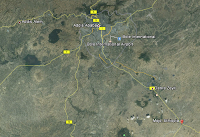 Ethiopia's Prime Minister, Hailemariam Desalegn, has given the go ahead to the Ethiopian Airports Enterprise to proceed with plans for a new Addis Ababa international airport, to be constructed near the town of Modjo.
Ethiopia's Prime Minister, Hailemariam Desalegn, has given the go ahead to the Ethiopian Airports Enterprise to proceed with plans for a new Addis Ababa international airport, to be constructed near the town of Modjo.![An overview of Addis Ababa Bole International Airport [Click to enlarge] An overview of Addis Ababa Bole International Airport](http://i.imgur.com/iwshC.jpg) |
| Overview of Bole Airport (RStehmann) |
The Ethiopian Ministry of Transport will now present the project proposal to the Council of Ministers for endorsement following which, it will be forwarded to the House of Peoples’ Representatives. According to a senior official at the EAE, financing for the airport is set to come via a loan from the Chinese Export-Import Bank.
With Addis Ababa's current airport, Bole International, set to exceed its designed capacity sooner than expected in the next few years, and with carrier Ethiopian Airlines (ET) set to radically expand both its fleet (by December, 14 new aircraft alone this year will have arrived) and its Cargo/MRO operations at the airport, the EAE will have to move quickly.
Of particular interest though is the choice of location, more for its altitude than its latitude. With Bole International sitting at 2'334m ASL, an enormous take-off penalty is imposed on departing aircraft, and with global oil prices currently at USD100+ per barrel, every advantage will have to be found in order to make the future airport as attractive and competitive as possible to carriers:
An independent aviation expert told The Reporter that the new location is chosen because of its low altitude. “As the altitude decreases, aircraft’s fuel consumption decreases, especially during take off. At lower altitudes aircraft take off load increases,” the expert said. “Modjo is an ideal location."
Modjo, Ethiopia (GoogleMaps)
Addis Ababa is known for its high altitude. Aircraft engines operate under stress and consume more fuel specially during take-off. That is the reason why aircraft manufacturers such as Boeing and Airbus choose Addis Ababa Bole International Airport for conducting taste flights.
With Modjo at 1'788m, altitude will still play a significant role in aircraft performance.
In a strange development however, once the construction of the new airport is completed, Bole International Airport is to be used for regional flights, VIP
flights and for general aviation, whilst the new airport
will accommodate long-haul international flights. How this will affect Africa-Europe, America, Asia, Middle East travel and flight connections has not yet been mentioned, though it will certainly prove to be an important issue if Addis Ababa is to remain a transit point of convenience.

